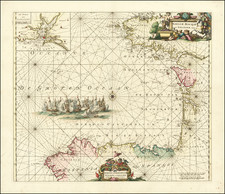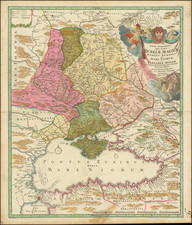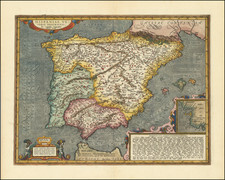
Gorgeous full color example of the western half of Nolin's Wall Map of Catalonia, one of the rarest and most sought after of all maps of Catalonia of the period. This example is in a gorgeous old wash coloring and includes town views of Barcelona, Girona, Rose, Tortose, Ostalric, Palamos, and Castel-Foilit. Large inset of Vallee D'Aran in the Pyrennes. Extends from Andora and the Pyrennes to the Mediterranean, with the towns of la Trinite, Martorel, Colbato, Torres, Quixols, S Etienne de Corvovira, Villanueva and Masanes and Cardone in the Eastern part of the map. Tarragon appears on the coastline.
Jean-Baptiste Nolin (ca. 1657-1708) was a French engraver who worked at the turn of the eighteenth century. Initially trained by Francois de Poilly, his artistic skills caught the eye of Vincenzo Coronelli when the latter was working in France. Coronelli encouraged the young Nolin to engrave his own maps, which he began to do.
Whereas Nolin was a skilled engraver, he was not an original geographer. He also had a flair for business, adopting monikers like the Geographer to the Duke of Orelans and Engerver to King XIV. He, like many of his contemporaries, borrowed liberally from existing maps. In Nolin’s case, he depended especially on the works of Coronelli and Jean-Nicholas de Tralage, the Sieur de Tillemon. This practice eventually caught Nolin in one of the largest geography scandals of the eighteenth century.
In 1700, Nolin published a large world map which was seen by Claude Delisle, father of the premier mapmaker of his age, Guillaume Delisle. Claude recognized Nolin’s map as being based in part on his son’s work. Guillaume had been working on a manuscript globe for Louis Boucherat, the chancellor of France, with exclusive information about the shape of California and the mouth of the Mississippi River. This information was printed on Nolin’s map. The court ruled in the Delisles’ favor after six years. Nolin had to stop producing that map, but he continued to make others.
Calling Nolin a plagiarist is unfair, as he was engaged in a practice that practically every geographer adopted at the time. Sources were few and copyright laws weak or nonexistent. Nolin’s maps are engraved with considerable skill and are aesthetically engaging.
Nolin’s son, also Jean-Baptiste (1686-1762), continued his father’s business.


![Utriusque Castiliae nova descriptio [New Description of Both Castiles]](https://storage.googleapis.com/raremaps/img/small/79695.jpg)


![[Galicia & Asturias] Le Royaume de Galice Divise en plusieur Territoires et Les Asturies Divisees en Asturie D'Oviedo et de la Santillana Dressez Sure les Memoires de Rodrigo Mendez Silva . . . 1704](https://storage.googleapis.com/raremaps/img/small/33010mp.jpg)
